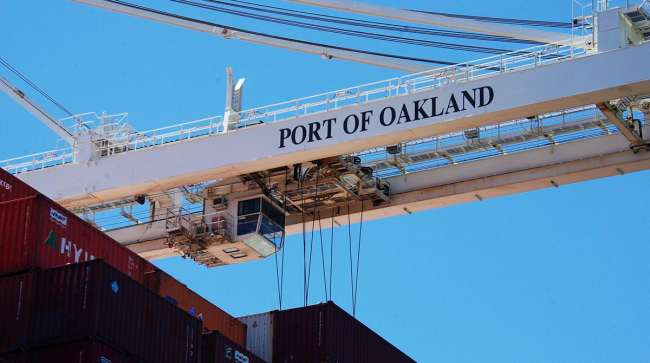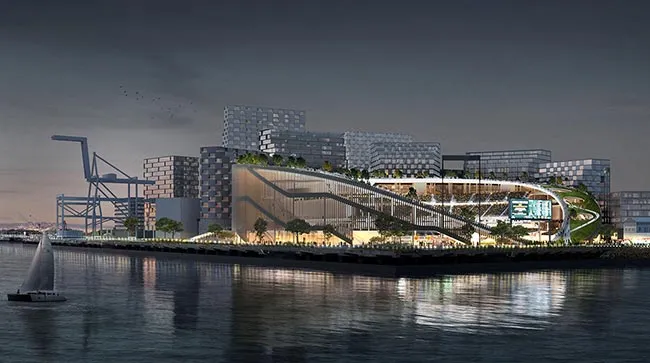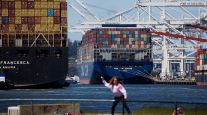Senior Reporter
Prospects Unlikely for Baseball Stadium at Port of Oakland

[Stay on top of transportation news: Get TTNews in your inbox.]
A yearslong effort to win approval for a multibillion-dollar commercial facility at the Port of Oakland, which would have included a new stadium for Major League Baseball’s struggling Oakland Athletics, seems to have failed.
The American League team is likely headed for a new home on the Las Vegas Strip, possibly in time for the 2025 baseball season.
Nevada Gov. Joe Lombardo signed a $380 million law that includes public funding for a state-owned 30,000-seat stadium at the site of the Tropicana Las Vegas Casino Resort.
Transportation industry organizations, including the Harbor Trucking Association and California Trucking Association, had opposed the plan to use the abandoned Howard Terminal at the Oakland facility to construct a stadium to replace the dilapidated Oakland-Alameda County Coliseum, generally regarded as one of the worst ballparks in MLB. Those groups urged the A’s to remain in Oakland, but instead use a parking lot adjacent to the existing Coliseum and construct a new park there, because it would not impact port operations and that location is already the site of an Amtrak station. It is also part of the Bay Area Rapid Transit system, with a designated station, on the rail line to Oakland International Airport.

Artist's rendering of a water view of the proposed ballpark at Howard Terminal. (Bjarke Ingels Group/Oakland Athletics via AP)
Meanwhile the Port of Oakland reported a 20.4% year-over-year decline in cargo volume in May, due to the labor dispute between the Pacific Maritime Association and the International Longshore and Warehouse Union, as some workers didn’t show up to work to voice their displeasure with the slow pace of contract talks.
A tentative agreement was reached last week and the ILWU’s more than 22,000 workers will vote on the six-year pact this summer.
The port said it processed 178,549 20-foot-equivalent unit (TEU) containers in May compared with 224,302 the previous year.
At the neighboring ports of Los Angeles and Long Beach, officials are breathing a sigh of relief that there is a labor contract before the rank-and-file. They have said for more than a year that a deal was the key to returning some of the volume to those facilities that has been lost to ports on the East Coast and the Gulf of Mexico.
“The tentative agreement between the International Longshore and Warehouse Union and the Pacific Maritime Association brings the stability and confidence that customers have been seeking,” said Gene Seroka, executive director of the Port of Los Angeles.
Still, Los Angeles reported a 19.5% year-over-year decline as it processed 779,140 TEUs in May compared with 967,900 in May 2022. Both ports also experienced labor shortages as negotiators came down to the wire to reach a deal, and several business days were lost as a result.
The Port of Long Beach reported a nearly 15% year-over-year decline in May, processing 758,225 containers compared with 890,989 a year ago.
The Northwest Seaport Alliance, which operates the Port of Seattle and nearby Port of Tacoma, did not have TEU numbers available at press time.
In the Gulf of Mexico, Port Houston reported a 10% year-over-year decline in container cargo, processing 300,482 TEUs, compared with 335,366 a year ago.
Still, even with the decline, Houston has processed more than 1.54 million TEUs through May, down only 2% compared with the record-breaking volumes of 2022.
The Port of Savannah processed 400,511 containers in May, off 22.8% compared with 2022’s 519,388, which was the fourth-busiest month in port history.
Georgia Ports Authority Executive Director Griff Lynch outlines @GaPorts $1.9 billion in infrastructure projects currently underway to meet the changing landscape of global shipping at the annual Georgia Foreign Trade Conference. https://t.co/eUYloBEqxF#GrowingBig — Georgia Ports (@GaPorts) June 12, 2023
Even with the year-over-year decline, port officials are forecasting the facility will be ready to handle an expected surge of freight to as many as 10 million containers annually as a result of their nearly $2 billion expansion plan, which will be completed in late 2026.
“As the nation’s fastest-growing region, the South is seeing increased consumer demand, which translates into higher port volumes,” said Griff Lynch, executive director at the port.
The Port of Virginia saw its May volume numbers decline by nearly 22.2% year-over-year to 265,875 containers compared with 341,611 a year ago.
Port officials are talking optimistically about new service that began in late May where Virginia will be the first East Coast port to receive weekly cargo from direct service as part of the reworked EC4 vessel service from Southeast Asia.
“This service is taking advantage of our ability to efficiently handle big ships, their cargo, our rail reach into critical Midwest population and manufacturing centers,” Port CEO Stephen Edwards said.
Want more news? Listen to today's daily briefing above or go here for more info
In April the port began daily rail service with Norfolk Southern to a new intermodal facility near Memphis.
The South Carolina Port Authority reported a 22% year-over-year decline to 198,104 TEUs compared with 255,824 a year ago.
The Port Authority of New York and New Jersey typically posts its container figures one month behind the other ports. In April it reported a 20.1% year-over-year decline to 648,390 containers, compared with 811,786 in April 2022.


